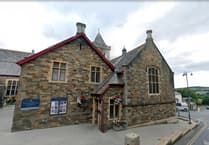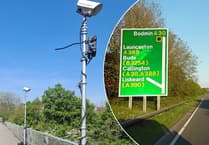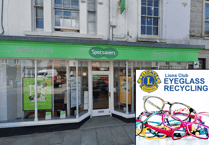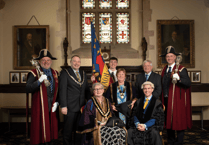A BRIEF history of the life and work of Launceston’s late poet was shared by one of his former pupils during the Charles Causley Festival.
Jane Nancarrow, who was taught by Charles Causley at the Old National School and has fond memories of him as both a teacher and poet, led a walk around many of the locations that inspired Causley’s poetry on Saturday, giving moving readings along the way.
Starting off at the Eagle House Hotel, Jane said she was sure Charles Causley ‘would be thrilled’ it re-opened last year to the public, after previous owners had sought planning permission to change the use of the Georgian building to residential. There, Jane read his poem ‘Eagle One, Eagle Two’, written about the twin statues outside the hotel.
Jane said before commencing the walk: “Lots of people think Charles was a children’s poet and yes he wrote brilliant children’s poems we all love, but he goes far beyond that as well.”
At the church of St Mary Magdalene, which Jane said Causley ‘would walk past most days’, she read ‘A True Ballad of Sir Henry Trecarrell’ — Sir Henry Trecarrell rebuilt the parish church in 1511.
Just around the corner, some had a go at trying to land a pebble on Mary Magdalene after Jane read ‘Mary, Mary Magdalene’. A long-standing local tradition says that if you toss a pebble over your shoulder and it comes to rest on her back you will have good luck.
It was then on to the parade ground, when those on the walk could look out to Ridgegrove Hill, the site of Causley’s former home of Cyprus Well. Jane explained how Charles had been born down by the river, and his father had died when he was young. Their house at Riverside, St Thomas, would flood, and when they came across a water rat in the kitchen, Charles and his mother moved to St Thomas Hill. They also lived at Tredydan Road before moving to Cyprus Well, where, Jane said, Charles lived for more than 50 years, adding: “He loved his house.”
She read his poem, ‘Sibard’s Well’, before it was on to the castle green to hear Jane read ‘Mr Pennycomequick’ and ‘On Launceston Castle’.
Looking out from the edge of the castle green to the north of the town, Jane told how Charles’ mother came from Langore and would walk to school at St Stephens. There, Charles’ mother and fellow pupils one day saw a dancing bear brought by a keeper, who would make it perform before the keeper collected pennies in his ‘begging-cup’ — this tale related as Jane read ‘My Mother Saw a Dancing Bear’.
‘The Quarter-jacks’ was read at the Castle entrance, opposite the Town Hall and Guildhall, where the two quarter-jacks can be seen set into the front face of the tower.
A short trek down St Thomas Road brought the walk to the Old National School, where Causley was a pupil, and where he started teaching in 1947. Jane gave a reading of ‘In the Willow Gardens’, before moving on to Tredydan Road where she could reflect on his earlier life. It was there he would sit outside and play his piano, and was a short walk from the office he worked at after his mother got him a job as a teenager. Jane said: “He thought ‘is this it then? Am I going to work in this little office for the rest of my life?’”
And although the Post had to depart the walk early here, at Tredydan Road, with the walk moving on round the corner to Riverside and the location of Causley’s first home, we were grateful to have a glimpse into what would have been ‘Causley’s Launceston’, one very different to that we know today. Jane remarked: “We once had a station, a cinema, and market! Where has it all gone?"
You can see a video of Jane reading ‘Mary, Mary Magdalene’ on The Post Series Facebook page.





Comments
This article has no comments yet. Be the first to leave a comment.